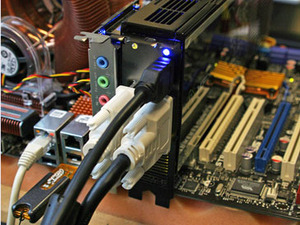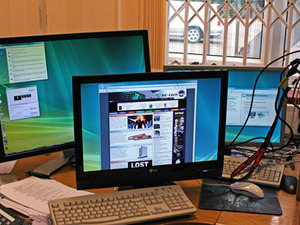Let's talk about drawbacks...
When I went over the card's design and features, I briefly touched on its display output capabilities and mentioned that there were some limitations with the implementation.With two G92 GPUs, you'd be right to think that there is the capability for four display outputs – there are only three on the GeForce 9800 GX2, but that's not really the issue.
First of all, you can only boot from either the HDMI or DVI-I connectors that are next to each other – the second DVI-I connector is only activated once in Windows. Secondly, that second DVI-I connector cannot be used if the card is in performance mode (i.e. when SLI is enabled) and in order to activate it, you have to go into the driver and disable multi-GPU mode.
This was a limitation with the GeForce 7950 GX2 that meant the card still had the limitations of any other multi-GPU setup and it's disappointing to see that the limitation is still there on the GeForce 9800 GX2.
We pressed the issue with Nvidia—because all of us are multi-monitor users in the bit-tech office—and it did inform us again that there was a driver coming that would enable multiple monitor support when SLI is enabled. This is the same thing we were told when we were discussing Hybrid SLI with Nvidia earlier in the year and the situation hasn't changed – there's no confirmed timeframe for the driver at the moment... but it's being worked on.
What's really disappointed me during the briefing though was the fact I was categorically told that you would not be able to run three monitors when the card is running in multi-monitor mode – it was a major drawback for me, as an avid multi-monitor user. I asked for clarification on this and the company's representatives said that you would only be able to use DVI+DVI or DVI+HDMI, and not DVI+DVI+HDMI.
Rather than just writing a full-blown rant about this, I decided that the best thing to do would be to test it out before going down that route. Now, I know that running three monitors is a niche, but if there are three connectors, you should really be able to use them all. To my surprise, I was able to use all three display outputs at the same time – this went against what Nvidia had said during the briefing, but it really did change my opinion about the card in some respects. Obviously, the driver switch is a pain in the back side and it means that the limitations of SLI are still on full view with this card – in fact, I can see it turning people away from the GeForce 9800 GX2 until the drivers support multi-monitors in SLI mode.
It has been one of the big downsides of multi-GPU technology ever since its inception and with games such as World in Conflict and Supreme Commander supporting multiple monitors, it's a big shame because there is untapped performance to deliver a better multi-display experience in these games... and a more pleasurable experience using the card in a gaming-cum-work machine. In fact, it was only recently that AMD actually managed to implement a driver fix that allows more than one monitor to be used in 3D mode and it's a major advantage for AMD's ATI Radeon HD 3870 X2 at the moment.
Obviously, the other drawback with having a graphics card with multiple GPUs is that the drivers have to enable support for SLI (in the case of the 9800 GX2) or CrossFire (for the 3870 X2) when new titles are launched. Most of us—especially those of us with really kickass gaming systems—want to play the game with the best experience possible the day it comes out. Drivers that don't support SLI/CrossFire in new games are therefore quite a big drawback for end users.
The good thing then is that Nvidia has worked hard over the past twelve months to deliver SLI support in the top games released last year... on their day of release. OK, performance scaling isn't fully optimised, but there was scaling to some extent. This is something that AMD needs to work towards as well if it's serious about a multi-GPU future.
No talk about multi-GPU drivers would be complete without mentioning the GeForce 7950 GX2 because Nvidia really made a mess of that one. When Windows Vista launched, there was no SLI support, which meant that a six-month old £400+ graphics card was now slower than a GeForce 7900 GT – a card that was less than half the price of Nvidia's last dual-GPU effort.
We called Nvidia out on this and its lack of transparency on the situation – customers wanted to know what was going on. And after spending a few hours on the phone with one of Nvidia's top driver guys in the small hours of the morning, we finally got some clarity – a beta driver turned up in late March and this finally gave those that had bought a GeForce 7950 GX2 the levels of performance they'd paid for less than nine months earlier.
I guess the good thing for Nvidia on this front is that there isn't a new operating system due until 2010 according to the latest rumours, so GeForce 9800 GX2 owners aren't going to be left in the same situation as the GeForce 7950 GX2 buyers were. That said, those that were burned by that whole scenario will have probably vowed never to buy another 'single' card with multiple GPUs... and I frankly can't blame them.
My feelings for multi-GPU graphics cards haven't changed a great deal since the Radeon HD 3870 X2's launch and, as a result, I recommend reading over my discussion of the benefits and drawbacks of diving into the world of multi-GPU graphics cards in that article. It'll save me repeating myself again here.

MSI MPG Velox 100R Chassis Review
October 14 2021 | 15:04











Want to comment? Please log in.